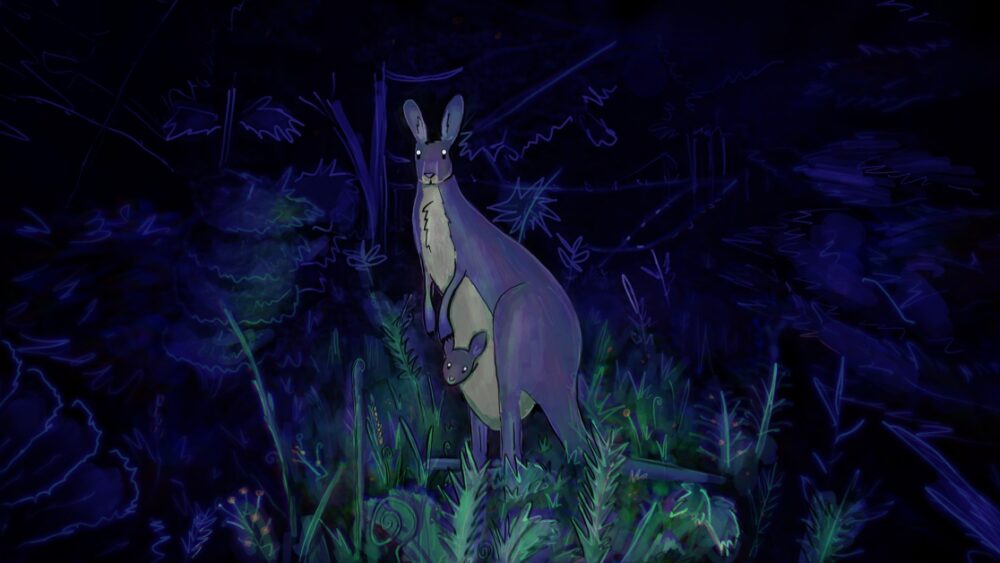For most of his development career, Billy Basso has attended gaming conventions on a work and promotional capacity. He’d stand near an incomplete game demo kiosk, watching people play it, taking notes, figuring out if he’s on the right track. Analyze, focus, guess, and hope.
In September, he finally got a taste of the other side of the booth.
“PAX West was the first show that happened after Animal Well’s launch,” Basso says weeks later from his home studio in Chicago. “I was looking forward to taking, in a way, a victory lap.” He describes a crowd of people lining up at the Seattle expo–not to play a new game, but to greet Blasso and share “all of these stories” about their positive experiences with his months-old title.
As Animal Well’s sole coder, artist, and designer, Basso deserves the lap. Since its April 2024 launch on consoles and PCs, the indie “Metroidvania” game has amassed nearly universal acclaim. Sales estimator Gamalytic points to sales figures exceeding 300,000 copies on Steam alone. During its launch month, Animal Well at one point outsold every first-party Nintendo game on Switch’s eShop.
In a chat with Game Developer, Basso and his business partner, Dan Adelman, reflect on Animal Well‘s development, launch, and success. What worked? How did surprising fare, like a Wisconsin tourist attraction and the 3D adventure Shadow of the Colossus, inspire and guide the game’s unique spin on Metroidvanias? And what might come next?
Related:Creature feature: The surreal pixel art and animation of Animal Well
Opting out of battles with pre-made engines
The Animal Well journey began in two phases, Basso says: a quick stab at a Metroidvania-styled prototype in 2012, and a bespoke engine project that he took more seriously, which he began coding alone in 2014 during his day job’s off hours. That day job, to clarify, was programming work at the video game studio Phosphor Games.
“I was typically working on mobile games with live service elements that were heavily dependent on network infrastructure,” he says. “We were using off-the-shelf game engines that had a lot of bloat and were laggy.” Having his own bespoke, offline engine was a priority for whatever kind of game he would eventually make on his own, to avoid the “sour taste” of inefficient tools and workflows.
But Basso’s work on a “general purpose, 3D game engine” dragged on during nights and weekends for three years before he came to a tough conclusion: the engine-focused project had been too focused on “preemptively solving problems,” instead of “having enough direction to actually turn into a game.”
It was 2017, and some of the design ideas from his 2012 Metroidvania lark had continued pulling on him, so Basso “wrote off” his 3D engine as “a learning experience” and started anew with 2D search action as a priority. Like before, off-the-shelf solutions weren’t going to cut it, but at least this time, he had a genre and some design directives in mind.
For his new game, he wanted pixels to scale perfectly to a variety of common screen resolutions, along with visual effects that meshed well with his integer-scaled pixel art. He disliked “built-in lighting effects” that developers had to “fight against quite a bit” in engines like Unity: “they have point lights and stuff, they have a smooth gradient, and that clashes with pixel art.”
Build your own technology, then let it set the tone
With that baseline in mind, Basso’s early project took shape, but roughly one year in, he found it “looked like an NES game, where the art wasn’t that striking.” Thanks to his full control of the engine and rendering efficiency at the fore, Basso had more wiggle room at this point in development to add what he describes as a crucial technical upgrade: a rim light shader.
“Everything was now kind of in shadow, but the edges were highlighted, and your character sprite in the bushes got blended in with the foreground tiles in a way that tied it all together,” Basso says. “Immediately, when I got that shader working, I’m like, ‘This is a unique look.”
The inspiration dominos began falling. Basso noticed that his effects’ shadow-and-light interplay “informed the stylistic direction” of the game’s environments and animals. Newly inspired, he built a “full screen Navier-Stokes fluid simulation” to power the game’s smoke and water effects for more haziness and dreaminess, along with more lighting and particle-effect systems, painting more highlights and posterization effects over backgrounds and sprites.

Image via Billy Basso/BigMode.
“This is interesting,” Basso recalls thinking, “where I have this high-fidelity physics simulation working, but it’s being paired with this, in some ways, primitive pixel art.” As Basso’s work bounced between design, art, and engine development, “the richness of the game got layered on, and I found the game’s tone and identity gradually over that process.” Despite his earlier hiccups with a 3D engine, he still recommends an engine-first mentality for new game development: “That opens up a lot of unique creative avenues. Once I get a cool system working, then I can play around with it and see what it allows for.”
Digging the well with Adelman’s aid
With his 2D game in full swing, Basso inadvertently learned about Adelman, a business- and marketing-focused industry veteran, through a pair of interviews in late 2017 and early 2018. Basso appreciated hearing how Adelman had transitioned from revolutionizing Nintendo’s digital distribution channels to dedicated support for indie devs, particularly for the breakout Metroidvania hit Axiom Verge. “I’m naturally a pretty introverted person, so having someone like him to work with sounded very appealing to me,” Basso says. He sent a cold-call email.
In hindsight, Adelman admits that his near-instant email reply turned out to be a bit disingenuous. “What was special enough about [Animal Well] that made me think, ‘oh I want to work on this,’ versus what it eventually became, were actually very different games,” he says on the PAX West 2024 show floor. “I really like both games.” The game he originally envisioned landed somewhere between VVVVVV and You Have To Win The Game–since both eschewed combat in favor of exploration, puzzles, and hardcore platforming. For Adelman, the cherry on top was the early game’s emphasis on nooks and crannies, which might otherwise be hidden in shadow or other Basso-developed effects: “I really loved finding secret passageways that I walked past, like, four or five times before I noticed them,” Adelman says. “Like, oh, this opens up into a whole new area!”
With Adelman on board, Basso’s more richly developed prototypes started getting in front of industry players, and Animal Well‘s first major reveal came in a small booth at the inaugural Summer Game Fest in June 2022, an in-person event in the wake of the defunct Electronics Entertainment Expo (E3). That event’s biggest Animal Well payoff came one week later, as a six-second blip in a wrap-up video made by popular YouTube creator Jason “Dunkey” Gastrow.
A big leap with BigMode
“Jason, in his normal style, basically shit on the whole event, but he did give us a positive shout-out,” Adelman says. “Just from that one mention, our wishlist numbers had a big spike.” Shortly after this, Gastrow and his wife Leah traded follows with the Animal Well team on Twitter, which led to a series of DMs between Adelman and Leah during that September’s Tokyo Game Show. Leah requested a playable build of Animal Well; Adelman asked that it not be used as YouTube or Twitch content. Leah replied that she had something else in mind: “We’re starting a publishing label, called BigMode,” Adelman recalls her saying. “Would you have any interest in talking about that?”
Adelman had not planned to add a formal publisher to the Animal Well development period; after all, he didn’t need one for Axiom Verge. And the Dunkey YouTube channel’s reputation–full of curse words and overt trolling in online games–gave Adelman some pause: “is [Gastrow’s] real-life persona the same as his online persona?” (The past few years have seen other YouTube and Twitch creators take huge missteps in their own game-publishing efforts.)

Image via Billy Basso/BigMode.
But Adelman and Gastrow’s initial conversations were polite and promising. Game promotion and marketing were changing in the years since Axiom Verge. Jason’s online reach and the couple’s genuine enthusiasm filled an information gap for Animal Well at this point in development. Jason had made a career out of tapping into a modern gaming audience’s attention span–how people engage with new games and pick favorites out of a deluge of indies. If Gastrow saw something special in Animal Well, he could convince a lot of people to do the same. In short, what a good publisher does.
“This could be a disaster, or it could be a really good fit,” Adelman recalls thinking.
(When asked for comment on Animal Well‘s development and success at PAX West 2024, Jason Gastrow replies by repeating the same sentence twice: “I feel like one hundred penguins.” It is unclear whether this statement was in line with Gastrow’s humorous YouTube persona, or whether he was offering a hint about an undiscovered Animal Well secret, since the game prominently features penguins.)
“Layers” work–but they need to be distinct and appealing
Animal Well wastes no time hinting at its range of secrets. With no plot or narration, players begin running-and-jumping around a dark, eerie cave. In one direction, players can pick up an “egg” from a treasure chest with no indication of what it means or does. In the other direction, a squirrel runs away, and a rabbit is seen hiding in a seemingly unreachable corner of the screen. Neither of these hints is borne out with prompt clarification, and the mysteries and layers keep coming.
But that opening beat is nothing compared to Animal Well‘s “layers” of deeper puzzles. Some required dozens of players’ collaboration to figure out, and others required connecting specific hardware to a PC while playing the game. Layers found their way into Animal Well in a few ways:
With a publishing deal in place and budget settled, Bigmode, Adelman, and Basso agreed not to rush the game’s launch–and to let Basso ultimately lead on the development, implementation, and difficulty of the game’s crisscrossing puzzles. Basso would often hand a new build to Adelman and the BigMode team without spoiling its four “layers” of puzzles, though the deepest layer was so obtuse that its puzzles simply couldn’t be tested by Bigmode’s tiny team without cheat codes.
This part of the game’s development never exceeded Adelman’s “scope creep” bandwidth, as he found the deeper puzzle additions never added “bloat” to the development process. Basso would review feedback after each build was turned in and accept “maybe half” of the suggestions. “It wasn’t so much like I was asking permission ever to do something,” Basso says. “I kind of just did it.”
For Basso, Animal Well‘s deeper layers would have no value unless players connected with Animal Well‘s surface-level content. He drew inspiration from an unlikely 3D-adventure game: 2005’s Shadow of the Colossus, whose online community eventually began hunting for a “hidden” 17th “colossus” boss (which never existed).
“It was almost like a religious conviction that they wanted to find this missing part of the game,” Basso says. “But then you realize that that’s only true because Shadow of the Colossus is one of the most finely crafted games ever made, and people care that much because the base game is so compelling.”
Early on, Basso committed to one principle in particular: none of its items could be considered “staples” in other Metroidvania games. Midway through development, Basso inadvertently realized he’d leaned on children’s toys as the game’s foundation, including a Slinky, a yo-yo, a bubble wand, and a frisbee—which gave him immediate reference points for their designs, plus the freedom to add clever surprises to each (particularly the bubble wand’s unique “climbing” system). Basso likes the “safe bet” nature of the popular toys he picked out: “That’s already a proven interaction.”
Inspiration from The House on the Rock
The last step was to coalesce Basso’s artistic and design leanings in a way that would make his mysterious world inviting and exciting to explore, not confusing. Basso had his vision catalyzed after visiting The House on the Rock in Wisconsin. “It’s this ramshackle collection of weird objects that the original owner of the house collected, and he built all these expansions to store them all,” Basso says. “You can go in any direction and find cool stuff to look at. It’s always surprising, and you can’t really predict what the through line is between all of them, but it still feels consistent.”
Basso says he wanted to make “the video game version” of the tourist attraction, though his version would include an unspoken mythology defined by “all the weird, Midwestern lawn ornaments I was seeing in my neighborhood.” This explains some of the game’s atypical animals standing amongst overgrown, lawn-like weeds (hello, pink flamingos), but Basso also describes an effort to keep his game’s animals as unique as its items.
Basso admits leaning towards a cast of animals in the game because he finds them “more enjoyable” to draw than humans, and that he can have more creative license since people on average are “more forgiving about the [visual] details, about what they look like.” His initial impulse was to draw “more zoo animals,” Basso says. “There’s a zebra in the [early versions]. And there’s just some, like, bears.”

Image via Billy Basso/BigMode.
As the game’s more mysterious tone took shape, Basso began watching nature documentaries on YouTube, then found himself compelled by the weirder, less popular animals he saw. “I remember learning that the beluga whale can imitate the sound of children underwater,” Basso says. “They trick a lot of divers into thinking there’s a child drowning.” He might have otherwise picked a better-known creature to fit whatever biome he needed (water, forest, cavern, etc.), but documentaries shaped his excitement: “Oh, I like this detail. That’s scary and creepy and interesting.” He thus filled out the Animal Well.
Community matters—with a pre-release twist
Adelman admits that before working on Animal Well, he’d never focused pre-release efforts on the concept of community, and he was particularly ambivalent about one popular service, which he’d seen other game developers adopt for their own games with mixed success. “I guess we’ve got to start up a Discord server and hope people show up,” Adelman recalls initially thinking. But in the game’s run-up, Basso hid a number of puzzles across the game’s promotional channels, including videos and website posts–all hinting to the caliber of puzzles that would eventually debut in the game’s deeper layers. The resulting Discord engagement was immediately massive. “These ARGs brought a lot of people together, and friendships started to form,” Adelman says. “So I was like, ‘Oh, I get what [people] mean now, when they talk about building community.'”
Before that full community could coalesce, Adelman elected to test one unique version of “community”: a pre-release, critics-only Discord channel. In addition to giving critics a few weeks to play the final game, Adelman wanted to provide a meeting place for critics to “share information and collaborate on certain puzzles,” admitting that Basso’s design vision always included an expectation of community-driven puzzle solving. (In other words: it’s not cheating to ask for Animal Well help!)
This had two outcomes for the very small Animal Well development team: First, the developers could see in real time a miniature version of how Animal Well would be digested by a community at large–something that couldn’t necessarily be replicated by a dedicated QA team. Second, it arguably bumped the game’s review scores. “I think if everyone had been playing in isolation, they might have missed out on some things,” Adelman says. “Sometimes a reviewer would say, ‘I just found this,’ and everyone would be, like, ‘What?! I gotta look for that.” We might have gotten a lot of 7 out of 10s, 8 out of 10s, if people didn’t seek out some of the more interesting content or didn’t know where to find it.”
Not “niche,” but “intense”
The community’s response to Animal Well‘s pre-release ARG puzzles gave Basso confidence to build complex puzzles for the final game, and that community responded even more fiercely to the final retail game. “People really appreciated the secrets in the game,” he says. “I’d assumed there’d be a hardcore group of people that that appealed to. And most people would just enjoy the game. Maybe that is the case, but I think everybody that did experience those deeper, later parts of the game, they all seemed to really resonate with it.
Still, when the game’s deepest riddles were uncovered by the community–particularly a cypher whose only hint is the pixel-long direction a bunny’s ears are turned–Adelman and Basso admit they were shocked by how quickly it happened.
Adelman suggests the internal estimate for full puzzle discovery was somewhere around ten years. “There were so many people who were so passionate about Animal Well, that there were probably, you know, ten man-years dedicated in that condensed amount of time,” Adelman says. “It was just way more people working way harder on [the game’s puzzles] than we ever expected.” (Basso insists that “there are some things the community hasn’t found” in Animal Well but has not elaborated further.)
As Basso speaks to trusting his development instincts, he confirms that he’s “thinking about another game” and is thus in the “very early stages of setting a new project and engine up.” He intends to deliver something similar to Animal Well‘s scope, if not something “bigger.”
“I’m looking forward to releasing a game within the context of having already released Animal Well,” Basso says. “I think I’ll have more flexibility with how it is marketed, and it will be fun to play off, and subvert, existing fans’ expectations.” And he clarifies that the afterglow of Animal Well’s launch, including a “victory lap” where feedback has moved from comment sections to critical accolades and real-life lines, made years of solo-development isolation worth it. He had ultimate control over its tools, engines, art, and mechanics. Now, and forever, he says that’s out of his hands.
“Animal Well was this sort of pure side project where I could implement things in what I felt was the ideal way,” Basso says. “Robust, not dependent on things. [The result was] a timeless quality that older cartridge games have–that still have, like, really intense speed running communities. I wanted to make a game that, you know, could still have a fandom around it 30 years from now.”



